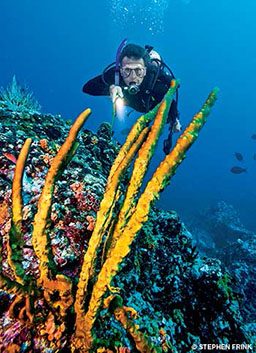Hometown: Bainbridge Island, Wash.
Age: 54
Years Diving: 36
Favorite Dive Destination: Anywhere underwater!
Why I’m a DAN Member: “DAN provides peace of mind when you travel to exotic destinations with unknown rescue and medical facilities.”
I first met Ed Viesturs on a dive trip to Panama. I was hired by a dive-light manufacturer to photograph him for an ad campaign. Here was a man who had been to the highest mountain peaks on the planet and enjoyed scuba diving; he could provide a credible endorsement for gear that goes both places. We had a great time diving off Coiba Island, but I was poorly adapted to keep up with him climbing into Panama’s highland jungles. I guess I shouldn’t have felt too bad to fall so far behind, for Viesturs had summited Mount Everest seven times and scaled all 14 of the world’s 8,000-meter peaks, all without the aid of supplemental oxygen.
The flatlands of Rockford, Ill., were an unlikely childhood home for one of the world’s foremost high-altitude mountaineers, but Viesturs’ life direction evolved vicariously after he read Maurice Herzog’s seminal 1951 account of climbing Annapurna, the first conquest of an 8,000-meter peak in the Himalayas. The disconnect between Viesturs’ Midwestern upbringing and his future passion was further exacerbated by his earliest sporting passion: competitive swimming. Endless laps back and forth in chlorinated water were a far cry from the freedom of pitting his own physicality against gravity and rock.

The mountains won out, and by the time Viesturs was ready to strike out for college it was to the University of Washington. With Mount Rainier and the Cascades so nearby, Seattle had become a hotbed of mountaineering activity, and Viesturs wanted to be a part of it. He was hopelessly addicted to climbing by then, and he eventually got a job as a guide on Mount Rainier. His peers were already going all around the world on climbing expeditions, and he soon figured out that if he worked hard and kept his mouth shut he might be invited along someday. In 1987 he was 10 years into his climbing career; he was getting stronger and more skilled as a mountaineer, and oddly he didn’t seem to be affected by the altitude. He soon became a go-to guy for alpine teams facing the inevitable hazards of the mountain.
In 1987 Viesturs also had his first opportunity to try to climb Mount Everest. Three months into that expedition and just 300 feet shy of the summit, he and his climbing partners decided to turn back in the face of a growing storm. Reflecting on that summit attempt, Viesturs commented, “Sure, we could have made it to the top, but we would almost certainly have died getting back down. The mountain decides whether you climb or not. The art of mountaineering is knowing when to go, when to stay and when to retreat.” In 1988 he tried again and once again was forced back to base camp. It was 1990 when he finally made it to the top of Everest, climbing all the way to 29,029 feet without using supplemental oxygen. Certainly, climbing without carrying a tank or wearing an oxygen mask is a more Zen-like approach — just the man and the mountain. But the challenge is massively greater and the accomplishment even more significant.
The ability to adapt to what others might have considered a failure was an early life lesson that has guided Viesturs’ considerable achievements ever since. He has made more than 200 ascents of Mount Rainier and has been on 29 Himalayan expeditions, including the 1996 IMAX Everest expedition chronicled in Jon Krakauer’s bestselling book Into Thin Air. These days Viesturs is still an active climber as well as an author and motivational speaker. He notes that many of the lessons he learned in the mountains have relevance to scuba diving. He suggests it is always appropriate to temper ambition with situational awareness and experience, and to be cognizant of one’s own limitations.
For many of the same reasons Viesturs tests his personal capabilities on the mountain, he is interested in learning more about freediving. He has studied the psychology of the sport and finds great similarities to the mindset required in high-performance mountaineering. Viesturs is also enjoying scuba through his children’s facemasks. He’s a father of four, and his oldest son just did his first Discover Scuba dives off Maui last year. But Viesturs isn’t forgetting his mountaineering roots as he instills the value of adventure in his children: He and his daughter are looking forward to a seven-day hike to 19,000 feet on Mount Kilimanjaro this summer.
© Alert Diver — Q3 Summer 2012